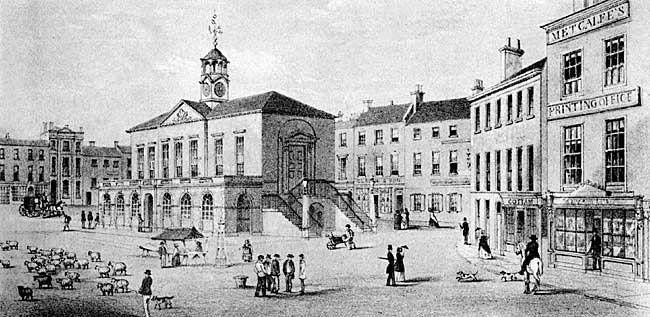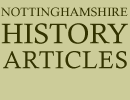East Retford in the 1850s
By Andy Nicholson

View of East Retford market square and town hall in the 1840s.
In 1850 Retford was the principal town of the Hundred of Bassetlaw (An ancient administrative division of the county covering a slightly larger area than Bassetlaw District Council) and was described as “a well-built, populous, improving, and busy market town, pleasantly situated on the River Idle and the Great North Road.”
William White’s Directory of Nottinghamshire, published in 1853, gives the glowing description of the town:
The market square (see engraving) looked very much like it does today with one important difference: the location of the Town Hall. In 1850 the Town Hall was sited at the north end of the square, outside the White Hart Hotel. It was a “plain, yet handsome and commodious structure” originally built in 1755 on the site of the medieval Moot Hall. The entrance was up two flights of stone steps at the north end. The large court room (70 feet x 26 feet) inside held the Quarter Sessions for the borough and the northern division of Nottinghamshire and was blessed with a fine ceiling: “the workmanship of the ceiling displays considerable taste, especially the centre and spandrills, the trellis-work being completed by four ornamental knots, and the whole finished by a rich and handsome cornice.” The court room was also used for public assemblies of the local gentry though, as a contemporary observer noted, they were like angels’ visits, “few and far between." Next to the court room was the smaller Council Room which contained full length portraits of King James I, King George II and his consort Queen Caroline. The room was used by the Grand Jury and also by the corporation who held it in Petty Session every alternate Saturday. In contrast to the finery of the rooms upstairs, the space under the hall was occupied by a butchers’ shambles.1
The old Town Hall must have proved inconvenient to the increasing amount of coach and other traffic passing through the town for the corporation decided in 1864 that "it would conduce greatly to a general accommodation and work out a striking improvement to the town, if the present [Town] Hall were taken down, and one of a more commodious and convenient kind erected." The current Town Hall, designed by Bellamy and Hardy of Lincoln, was built on the southern side of the square and opened in 1868; the old building was demolished the same year.
Other features of the market square included an elegant Doric pillar and pedestal, surmounted by five gas lamps, a water pump that drew water from a deep artesian well, and the Broad Stone.
There were three inns around the square: a coaching inn, The White Hart, the Half Moon and the Angel (which was situated near to where the NatWest bank now stands). There were also three banks, Cooke, Vernon & Co., a branch of the Nottingham and Nottinghamshire Banking Company and the Savings Bank.
The market during the 19th century was held every Saturday and was well attended and “abundantly supplied with meat, fowls, butter, eggs, fruit, &c. whence large quantities are conveyed to Sheffield and other parts of Yorkshire.” In fact, the Retford district was often called the market garden of Sheffield. Chartered fairs were held on the 23rd March and 2nd October for horses, cattle, cheese and hops; the last Thursday in June for lambs, the Thursday after 11th June and second Thursday in December for cattle, sheep and horses.
Cultural diversions for the citizens of Retford had included a theatre on Carolgate built in 1789 and managed by a Mr Pero. However, the theatre closed in 1843 and was rather unusually converted into a Primitive Methodist chapel. There was also a News Room in the Market Place, “liberally supplied with London and country papers”, which was well supported by the gentry. A Book Club, originally established in 1825, was in existence and charged members £1 11s 6d per annum. The Literary and Scientific Institution had a library in the Market Place, supported by contributions from a number of gentlemen contained a “large and well-assorted collection of books” was open to subscribers, “respectable strangers being also allowed the liberty of entrance gratuitously.”
1. The name "Shambles" comes from the Saxon English "Fleshammels", meaning "the street of the butchers",
